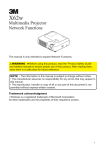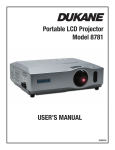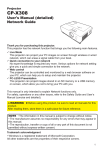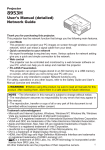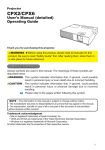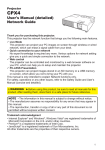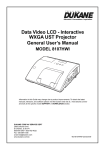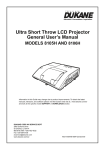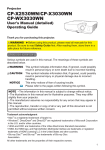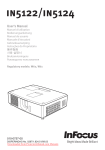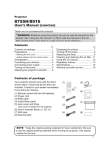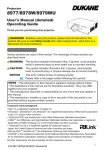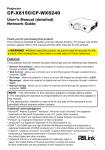Download User`s Manual – Network Functions
Transcript
Projector
8784
User’s Manual – Network Functions
SD
RD
CA
This manual is only intended to explain Network Functions.
WARNING ►Before using this product, read the “User’s Manual – Safety
Guide” and related manuals to ensure proper use of this product. After reading
them, store them in a safe place for future reference.
NOTE • The information in this manual is subject to change without notice.
• The manufacturer assumes no responsibility for any errors that may appear in
this manual.
• The reproduction, transfer or copy of all or any part of this document is not
permitted without express written consent.
Trademark acknowledgment
• Windows is a registered trademark of Microsoft Corporation.
All other trademarks are the properties of their respective owners.
Contents
Contents
Caution… …………………………………………………………………………………… 3
1. Main functions… ……………………………………………………………………… 5
1.1 Live Mode… ………………………………………………………………………… 5
1.2 PC-LESS Presentation … ………………………………………………………… 6
2. Equipment connection and network setting … …………………………… 8
2.1 Required equipment preparation………………………………………………… 8
2.2 Network connection using “One-Click-Communication”
function… …………………………………………………………………………… 8
2.3 Manual network connection setting – Wired LAN - … ……………………… 10
2.3.1 Equipments connection……………………………………………………… 10
2.3.2 Network settings… …………………………………………………………… 11
2.3.3 “Internet Option” setting… ………………………………………………… 14
2.3.4 Check connection……………………………………………………………… 15
2.4 Manual network connection setting – Wireless LAN - … …………………… 16
2.4.1 Preparation for wireless LAN connection ………………………………… 16
2.4.2 Wireless LAN connection set up… ………………………………………… 17
2.5 Configuring and controlling the projector via a web browser……………… 19
2.5.1 Network Information… ……………………………………………………… 22
2.5.2 Network Settings… …………………………………………………………… 23
2.5.3 Port Settings… ………………………………………………………………… 25
2.5.4 Mail Settings… ………………………………………………………………… 26
2.5.5 Alert Settings…………………………………………………………………… 27
2.5.6 Schedule Settings……………………………………………………………… 29
2.5.7 Date/Time Settings… ………………………………………………………… 31
2.5.8 Security Settings… …………………………………………………………… 33
2.5.9 Projector Control… …………………………………………………………… 35
2.5.10 Projector Status… …………………………………………………………… 38
2.5.11 Network Restart… …………………………………………………………… 38
2.5.12 Logoff…………………………………………………………………………… 38
2.6 Utilize Web Remote Control… …………………………………………………… 39
3. How to use projector software – Basics - …………………………………… 41
3.1 How to use “MIU Live Viewer” …………………………………………………… 41
3.1.1 Install “MIU Live Viewer” … ………………………………………………… 41
3.1.2 Software Installation Procedure … ………………………………………… 42
3.1.3 Explanation of “MIU Live Viewer” … ……………………………………… 43
3.1.4 Utilize “MIU Live Viewer” – Basic - ………………………………………… 47
3.2 Utilize “PC-LESS Presentation” – Basic - ……………………………………… 50
4. Utilize projector – Advanced - …………………………………………………… 52
4.1 Utilize “MIU Live Viewer” – Advanced -… ……………………………………… 52
4.1.1 Connect multiple PCs with one projector (Multiple PCs
connection)… ………………………………………………………………… 52
4.2 Utilize “PC-LESS Presentation” – Advanced - ………………………………… 54
4.2.1 Thumbnail Mode… …………………………………………………………… 55
4.2.2 Full Screen Mode… …………………………………………………………… 57
4.2.3 Slide Show Mode… …………………………………………………………… 59
4.2.4 Directory Tree View… ………………………………………………………… 61
4.2.5 “PC-LESS Presentation” error message … ……………………………… 64
4.3 Playlist………………………………………………………………………………… 65
4.4 E-mail Alerts… ……………………………………………………………………… 66
4.5 Projector Management using SNMP… ………………………………………… 68
4.6 Event Scheduling…………………………………………………………………… 69
4.7 e-SHOT (Still Image Transfer) Display…………………………………………… 72
4.8 Command Control via the Network……………………………………………… 73
5. Troubleshooting… …………………………………………………………………… 75
6. Specifications… ……………………………………………………………………… 77
7. Warranty and After-sales service… …………………………………………… 78
Caution
Caution
[Restriction in terms of inserts or pulls memory card and wireless network card]
Do not pull out the memory card and the wireless network card while the power is on.
The memory card can be pulled out only while the card access LED is off.
Choose one of the following item either “REMOVE ALL”, “REMOVE SD CARD” or
“REMOVE USB” that matches a media to be taken out, from projector, when you
remove the SD card or USB memory. The item can be found on the menu “MIU →
SERVICE”. (MIU Menu of the User’s Manual - Operating Guide)
CAUTION
n
The accompanying IEEE802.11b/g wireless network card uses the 2.4GHz radio frequency
band. You do not need a radio license to use this card, but you should be aware of the following:
l
DO NOT USE NEAR THE FOLLOWING!
• Microwave ovens
• Industrial, scientific or medical devices
• Designated low power radio stations
• Premises radio stations
Using the wireless network card near the above may result in radio interference, which in turn
may result in a decrease in communication speed and even a complete loss of communication.
l
Depending on the location where you attempt to use the wireless network card, there may be interference
with the radio waves, which may result in a decrease in communication speed and even a complete loss
of communication. In particular, please be aware that using the wireless network card in locations where
there is reinforced steel, other metals and concrete may interfere with radio communication.
l
Available Channels
The wireless network card uses the 2.4GHz radio frequency band, but depending on the country
or region you are in, you might be limited to the channels you can use. Please refer to the following
table for confirming where and with what channels you may use the accompanying IEEE802.11b/g
wireless network card. Please consult with your dealer for countries not included in the table.
Country or Region
Available Channel
Japan
1 to 11
USA
1 to 11
Taiwan
1 to 11
Canada
1 to 11
UK, Spain, Germany, Italy, Austria, Switzerland,
Belgium, Sweden, Netherlands, Portugal,
Denmark, Finland, Greece, Norway, France,
Ireland, Luxembourg, Iceland
1 to 11
l
You may not bring the wireless network card into countries not listed above as there is
a possibility that use of the wireless network card in those countries could lead to an
infringement of established radio laws.
Caution
0560 !
The manufacturer (Gemtek) hereby declare that this equipment (SD wireless
network card), model SD-Link11g is in compliance with the essential requirements
and other relevant provisions of Directive 1999/5/EC.
1. Main functions
1. Main functions
1.1 Live Mode (Project images from PC)
The MIU (Multi Information processing Unit) enables “Wireless presentation” by
choosing Live Mode.
The Live Mode give you an ability to display a same image that is shown on the
PC through the network by using an application program “MIU Live Viewer”.
(Fig.1.1.a)
The “MIU Live Viewer” captures PC screen image and sends to the projector
through wired LAN or wireless LAN connection. (Refer to section 3 in detail.)
Fig. 1.1.a “MIU Live Viewer” outlines (through wireless LAN connection)
Fig. 1.1.b “MIU Live Viewer”
One projector can be connected with up to 4 PCs using “MIU Live Viewer”.
(52)
1. Main functions
1.2 P
C-LESS Presentation
(Display the images stored in SD Memory Card/USB memory.)
The MIU enables “PC-LESS Presentation” by choosing PC-LESS function. (Fig. 1.2.a)
The PC-LESS function enables to display images that are stored in the SD Memory
Card or USB memory. The “PC-LESS Presentation” has 4 types of display modes.
1) Thumbnail Mode: Display thumbnails stored images in SD Memory Card or
USB memory. (From now on, it is called “memory card” as SD Memory Card
and USB memory combined.)
2) Full Screen Mode: Display selected image or movie on the full screen mode.
3) Slide Show Mode: Display images as slideshow mode with certain interval.
4) Directory Tree View: Display files and folders that are stored in memory card as
directory tree view.
[Supported memory devices]
- SD Memory Card
-USB memory (USB memory type, USB Hard Disk and USB card reader type)
NOTE • USB memory reader (adapter) is not supported (if the adapter
acknowledges as multiple devices connected).
• The supported formats are FAT 12, FAT 16(FAT) and FAT 32. NTFS is not supported.
• USB hub is not supported.
6*7/$0#+.=5&?
㪈
㪋
+OCIG
+OCIG
㪉
㪌
+OCIG
+OCIG
㪊
㪍
+OCIG
2%.'55
24'5'06#6+10
/'07
5.+&'5*19
+OCIG
56#46
㪎
㪈㪇
+OCIG
+OCIG
㪏
㪈㪈
+OCIG
+OCIG
㪐
㪈㪉
5612
+OCIG
+06'48#.U
/1&'
10'6+/'
+OCIG
2.#;
;'5
'06'4
Fig. 1.2.a “PC-LESS Presentation” outlines
“PC-LESS Presentation” can be controlled via keypad on the Projector or IR
Remote (54).
You can also control using the Web remote controller, as shown in Fig. 1.2.b,
which enables selecting images, switching pages and switching display modes.
Web remote controller also switches mode between “Live Mode” and “PC-LESS
Presentation”. (39)
1. Main functions
1.2 PC-LESS Presentation
(Display the images stored in SD Memory Card/USB memory.) (Continued)
Fig. 1.2.b Remote Control
NOTE • There are several naming limitations for the folders and files.
(1) Alphanumeric and Japanese characters are supported if the language
setting is Japanese.
(2) Alphanumeric and Latin-1 characters are supported if the language setting
is NOT Japanese.
• The files may not be able to access depending on the type of USB hard disk,
USB memory and USB card reader.
• It recommends to use external power supply cable if the USB hard disk drive
has the power cable.
2. Equipment connection and network setting
2. Equipment connection and network setting
2.1 Required equipment preparation
Followings are required for 1 projector and 1 PC connection. Multiple PC
connection is described in section 4.1.
Projector: 1 unit
PC: 1 set (“MIU Live Viewer” installation is required for “Live Mode” usage.)
IEEE802.11b/g wireless LAN equipment is required.
Depending on the type of wireless network card and PC you are using,
the projector may not be able to communicate properly with your PC,
even if the PC you are using is equipped with built-in wireless LAN
function.
To eliminate communication problems, please procure a Wi-Fi certified
wireless network card.
LAN cable (in case of wired connection): 1 piece * 1
SD Wireless Network Card (in case of wireless connection): 1 unit * 2
Memory card (in case of “PC-LESS Presentation” usage): 1 piece
* 1: When a projector and a PC are connected, use CAT-5 (or greater) LAN cable.
* 2: Access point is required when wireless LAN connection is used as
Infrastructure mode.
2.2 N
etwork connection using “One-Click-Communication”
function
This section explains how to connect network using “One-Click-Communication”
function. This function makes PC and projector network connection very easy
without complicated settings like IP address and SSID.
* This function cannot be used when multiple PCs or multiple projectors are
connected.
* The system of Windows2000 Professional Service Pack 4 or Windows XP and
the administrator authority are required to use “One-Click-Communication”
function. (Administrator authority)
* This function only works when the network settings of the projector is the same
as factory default settings.
* This function might not work depending on your used wireless LAN driver.
If so, setup the connection manually. (10, 16 and refer to the User Manuals for
your PC and wireless equipment.)
[Wired LAN connection]
1) When projector network settings such as IP address and subnet mask are
changed, need to return to the projector factory default Network settings.
qPress the MENU button on remote control or the ▲/▼/◄/► button on
keypad. Then OSD menu will be displayed. If Easy Menu is displayed,
change the menu to Advanced Menu.
2. Equipment connection and network setting
2.2 Network connection using “One-Click-Communication” function
(Continued)
wSelect the MIU menu by using ▲/▼ button.
/'07=%1/276'4?
2+%674'
+/#)'
+0276
5'672
5%4''0
126+10
/+7
'#5;/'07
5'.'%6
.+8'/1&'
2%.'5524'5'06#6+10
5'672
G5*16
+0(14/#6+10
5'48+%'
ePress the RESET button on remote control. Then Reset Menu will be displayed.
/+7
4'5'6
%#0%'.
rPress the ▲ button to reset the Network settings.
NOTE • SSID, WEP Key will be set to factory default settings.
• If you like to set these items, please set again from Web browser (19).
2) Connect PC and projector using LAN cable to make it ready for communication.
* In case of connecting with existing network, contact your network administrator.
3) Start up “MIU Live Viewer”. Window appears in Fig. 2.2.a. (41)
Fig. 2.2.a “MIU Live Viewer” initial window
2. Equipment connection and network setting
2.2 Network connection using “One-Click-Communication” function
(Continued)
4) Click [One-Click] button in Fig. 2.2.a, then projector will be found. And the
capture start button is activated, then real time display will be started
automatically.
[Wireless LAN connection]
1) When projector network settings such as IP address and subnet mask are
changed, need to return to the projector factory default settings. (8)
2) In case IEEE802.11b/g wireless LAN device is built-in the PC, make the LAN
valid and other network connections invalid. If wireless LAN device is not built
in the PC, connect IEEE802.11b/g wireless LAN device and install device driver
to the PC. (Refer to the user guide for wireless LAN device details.)
3) Start up “MIU Live Viewer”, then the window appears (Fig. 2.2.a).
4) Click [One-Click] button in Fig. 2.2.a, then projector will be found. And the
capture start button is activated, then real time display will be started
automatically.
2.3 Manual network connection setting – Wired LAN When you need to set the original IP address and SSID other than factory default
settings, need to set up network connection manually.
This section explains how to set up network connection manually.
2.3.1. Equipments connection
At first, connect projector and PC with wired LAN connection to check PC setting
and connection status. Next section explains PC settings.
Connecting projector with network using LAN cable, and then set it ready to
communicate with PC.
* Connecting with existing network, contact network administrator.
At last, turn on the projector. This is the end of Equipments connection.
10
2. Equipment connection and network setting
2.3 Manual network connection setting – Wired LAN - (Continued)
2.3.2. Network settings
This is the explanation of network connection settings for Windows XP and
Internet Explorer.
1) Log on to Windows XP as administrator authority. (*)
2) Open “Control Panel” from “Start” menu.
3) Open “Network and Internet Connections” in “Control Panel”. (Fig. 2.3.2.a)
* Administrator authority is the account, which can access to all functions.
Fig. 2.3.2.a “Network and Internet Connections” window
4) Open “Network Connections”. (Fig. 2.3.2.b)
Fig. 2.3.2.b “Network Connections” window
11
2. Equipment connection and network setting
2.3 Manual network connection setting – Wired LAN - (Continued)
5) When more than 2 usable network devices exist, make only one device “Valid”
that you want to use and the rest of devices “Invalid”. (In this case, “Local Area
Connection” is selected.)
6) Open “Local Area Connection Properties” window you use for network device.
(Fig. 2.3.2.c)
Fig. 2.3.2.c “Local Area Connection Properties” window
7) Set used protocol as “TCP/IP” and open “Internet Protocol (TCP/IP) Properties”
window.
Fig. 2.3.2.d “Internet Protocol (TCP/IP) Properties” window
8) Set IP address, subnet mask and default gateway for PC.
12
2. Equipment connection and network setting
2.3 Manual network connection setting – Wired LAN - (Continued)
[About IP address]
Network address of PC IP address should be common with projector’s one but the
PC total IP address should not be overlapped with other networked equipments.
For example, projector initial settings are as follows.
IP address: 192.168.1.10
Subnet mask: 255.255.255.0
Therefore, specify PC IP address as follows.
IP address: 192.168.1.xxx (xxx shows decimal number.)
Subnet mask: 255.255.255.0
Select from 1 to 254 for “xxx” not duplicating with any other equipments. In this
case, projector has “192.168.1.10” IP address, specify from 1 to 254 except 10 for
PC.
Projector IP address can be changed by using configuration utility. (19)
* “0.0.0.0” cannot be set to IP address.
When DHCP server exists in network, it is possible to set using IP address, which
is automatically assigned to projector.
If projector and PC exist in the same network (i.e. network address is common),
default gateway can be blank.
* DHCP is abbreviation for “Dynamic Host Configuration Protocol” and the function
to provide necessary setting for network like IP address from server to client.
Server that has DHCP function is called DHCP server.
* When projector and PC exist in different networks, default gateway setting is
necessary. Contact network administrator in detail.
13
2. Equipment connection and network setting
2.3 Manual network connection setting – Wired LAN - (Continued)
2.3.3 “Internet Option” setting
1) Click “Internet Options” in “Network and Internet Connections” window
(Fig. 2.3.3.a) to open “Internet Properties” window. (Fig. 2.3.3.b)
Click
Fig. 2.3.3.a “Network and Internet Connections” window
Click
Fig. 2.3.3.b “Internet Properties” window
2) Click “Connections” tab and then click [LAN Settings] button to open “Local
Area Network (LAN) settings”. (Fig. 2.3.3.c)
14
2. Equipment connection and network setting
2.3 Manual network connection setting – Wired LAN - (Continued)
Fig. 2.3.3.c “Local Area Network (LAN) Settings” window
3) Uncheck all boxes in “Local Area Network (LAN) Settings” window. (Fig. 2.3.3.c)
2.3.4 Check connection
Check PC and projector are connected properly here. If it is not connected, check
cable connections and settings are properly or not.
1) Start browser in PC and specify following URL, then click “Go” button.
URL: http://(Projector IP address) /
For example, if projector IP address is 192.168.1.10, specify
URL: http://192.168.1.10/
2) After enter your ID and password, if Fig. 2.3.4 appears, it succeeds.
Fig. 2.3.4 “Logon Menu”
15
2. Equipment connection and network setting
2.4 Manual network connection setting – Wireless LAN
By installing SD-Link11g card, PC and projector are able to communicate in both
Ad-Hoc and Infrastructure modes.
How to set up wireless LAN connection manually.
2.4.1 Preparation for wireless LAN connection
SD
CAR
D
Fig. 2.4.1.a Without access point communication (Ad-Hoc)
SD
D
CAR
Fig. 2.4.1.b With access point communication (Infrastructure)
* Ad-Hoc is one of the wireless LAN communication methods without having
access point to communicate.
* Infrastructure is one of the wireless LAN communication methods with having
access point to communicate. If certain quantities of equipments are used, this
mode is efficient.
If communicating with existing network, contact your network administrator.
First, insert the SD wireless network card into SD card slot (Using an SD card of
the User’s Manual - Operating Guide).
Then, make PC ready for wireless communication.
In case IEEE802.11b/g wireless LAN device is built-in the PC, make it valid and
make other network connections invalid. If wireless LAN device is not built-in the
PC, connect IEEE802.11b/g wireless LAN device and install device driver. (Refer
to the user guide for PC and wireless LAN device for detail.)
16
2. Equipment connection and network setting
2.4 M
anual network connection setting – Wireless LAN (Continued)
2.4.2 Wireless LAN connection set up
Using wireless LAN utility for Windows XP standard.
Wireless LAN initial settings for the projector is as follows.
Connection Control : Ad-Hoc
SSID
: wireless
Channel
: 1ch
Encryption rating
: None
Communication speed: AUTO
IP address
: 192.168.1.10
* You can change these settings as you want. Use configuration utility or menu to
change. (19)
1) Open ”Network Connections”. (Fig. 2.4.2.a)
Fig. 2.4.2.a “Network Connections”
2) Make wireless network connection “Valid” and other network devices “Invalid”.
3) Open “Wireless Network Connection Properties”. (Fig. 2.4.2.b)
Fig. 2.4.2.b “Wireless Network Connection Properties” window (1)
17
2. Equipment connection and network setting
2.4 M
anual network connection setting – Wireless LAN (Continued)
4) Set used protocol as “TCP/IP” and open TCP/IP property. Set IP address and
other settings as same as wired LAN connection set up. (12)
5) Open “Wireless Networks” tab. (Fig. 2.4.2.c)
Fig. 2.4.2.c “Wireless Network Connection Properties” window (2)
6) Add check mark for “Use Windows to configure my wireless network settings”
in “Wireless Network Connection Properties” window.
7) Click [Add] button in “Preferred networks” section in “Wireless Network
Connection Properties” window (Fig. 2.4.2.c) to open “Wireless network
properties” window. (Fig. 2.4.2.d)
Fig. 2.4.2.d “Wireless network properties” window
18
2. Equipment connection and network setting
2.4 M
anual network connection setting – Wireless LAN (Continued)
8) Set each item as follows.
Network name (SSID): wireless
Data encryption: not enabled (Default setting is not enabled.)
* This explanation meets the projector default setting. If access point is used or
data encryption is used, if needs to change settings properly. Refer to PC or
wireless LAN device user guide for detailed information.
* If using the existing network via access point, contact your network administrator.
2.5 Configuring and controlling the projector via a web browser
You can adjust or control the projector via a network from a web browser on a PC
that is connected to the same network.
NOTE • Internet Explorer 5.5 or higher are required.
• If JavaScript is disabled in your web browser configuration, you must enable
JavaScript in order to use the projector web pages properly. See the Help files
for your web browser for details on how to enable JavaScript.
• If projector is disconnected from network approx. 50 seconds, system will
automatically log off. Please Re-log on to continue operations via a web
browser.
• After you log on, a small blank window will appear behind the main operation
window. Please do not close this small blank window. If this window is closed,
the system will automatically log off after certain period of time even if an
operation is being performed.
The small blank window will close when the main operation window is closed.
• The small blank window may be considered a pop-up and be blocked if you
are using Windows XP Service Pack 2, or using other security software.
If Service Pack 2 blocks the window the following message will appear:
"Pop-up blocked. To see this pop-up or additional options click here..."
Please select "Temporarily Allow Pop-ups" or "Always Allow Pop-ups From This
Site..." to allow the window to open.
• It is recommended that all web browser updates be installed. It is especially
recommended that all users running Internet Explorer on a Microsoft Windows
version prior to Windows XP Service Pack 2 install security update Q832894
(MS04-004) or the web browser interface may not be displayed correctly.
And when using an older version of Internet Explorer, during operations the
browser will log out after 50 seconds.
19
2. Equipment connection and network setting
2.5 Configuring and controlling the projector via a web browser (Continued)
When configuring or controlling the projector via a web browser, an ID and
password are required. There are two types of IDs, Administrator IDs and User
IDs. The following chart describes the differences between user and administrator
IDs.
Item
Description
Displays the projector’s current
Network Information
network configuration settings.
Administrator ID User ID
√
√
Network Settings
Displays and configures network
settings.
√
N/A
Port Settings
Displays and configures
communication port settings.
√
N/A
Mail Settings
Displays and configures e-mail
addressing settings.
√
N/A
Alert Settings
Displays and configures failure &
warning alerts.
√
N/A
Schedule Settings
Displays and configures schedule
settings.
√
N/A
Date/Time Settings
Displays and configures the date and
time settings.
√
N/A
Security Settings
Displays and configures passwords
and other security settings.
√
N/A
Projector Control
Controls the projector.
√
√
Remote Control
Controls the projector like IR remote.
√
√
Projector Status
Displays and configures the current
projector status.
√
√
Network Restart
Restarts the projector’s network
connection.
√
N/A
Below are the factory default settings for administrator IDs, user IDs and
passwords.
Item
Administrator ID
User ID
20
ID
Password
Administrator
<blank>
User
<blank>
2. Equipment connection and network setting
2.5 Configuring and controlling the projector via a web browser (Continued)
Refer to the following for configuring or controlling the projector via a web browser.
Example: If the IP address of the projector is set to 192.168.1.10:
1) Enter
[http://192.168.1.10/] into the address
bar of the web browser and the screen
in Fig. 2.5.a will be displayed.
2) Enter your ID and password and click
[Logon].
Fig. 2.5.a "Logon Menu"
If the logon is successful either the Fig.2.5.b or Fig.2.5.c screen will be displayed.
Fig. 2.5.b "Logon with administrator ID"
Fig. 2.5.c "Logon with user ID"
3) Click the desired operation or configuration item on the main menu located on
the left-hand side of the screen (Fig. 2.5.b or Fig. 2.5.c).
21
2. Equipment connection and network setting
2.5 Configuring and controlling the projector via a web browser (Continued)
2.5.1 Network Information
All screen images displayed in this manual are
screens of a logon using an administrator ID.
Any administrator only functions will not be
displayed when using a user ID. Refer to the
descriptions in each table.
Displays the projector’s current network configuration settings.
Item
Description
DHCP
Displays the DHCP configuration settings.
IP Address
Displays the current IP address.
Subnet Mask
Displays the Subnet Mask.
Default Gateway
Displays the Default Gateway.
MAC Ethernet
Displays the Ethernet MAC address.
Displays the Wireless LAN MAC address.
MAC Wireless
NOTE • MAC wireless will not be displayed when
the NETWORK MODE is set to the WIRED even if the
wireless network card is mounted. (MIU Menu of the
User’s Manual - Operating Guide)
Firmware Date
Displays the network firmware time stamp. This information is only
displayed when logged on using an administrator ID.
Firmware Version
Displays the network firmware version number. This information is
only displayed when logged on using an administrator ID.
22
2. Equipment connection and network setting
2.5 Configuring and controlling the projector via a web browser (Continued)
2.5.2 Network Settings
Displays and configures network settings.
Item
Description
Network Mode
Select Network mode "Wired" or "Wireless".
IP Configuration
Configures network settings.
DHCP ON
Enables DHCP.
DHCP OFF
Disables DHCP.
IP Address
Configures the IP address when DHCP is disabled.
Subnet Mask
Configures the Subnet Mask when DHCP is disabled.
Default Gateway
Configures the Default Gateway when DHCP is disabled.
Projector Name
Configures the Projector name.
The length of the Projector Name can be up to 64
alphanumeric characters. Numbers ‘0-9’ and alphabet ‘a-z’,
‘A-Z’ and symbols can be used.
sysLocation (SNMP)
Configures the location to be referred to when using SNMP.
The length of the sysLocation can be up to 255 alphanumeric
characters. Only numbers ‘0-9’ and alphabet ‘a-z’, ‘A-Z’ can
be used.
sysContact (SNMP)
Configures the contact information to be referred to when
using SNMP.
The length of the sysContact can be up to 255 alphanumeric
characters. Only numbers ‘0-9’ and alphabet ‘a-z’, ‘A-Z’ can
be used.
DNS Server Address
Configures the DNS Server address.
23
2. Equipment connection and network setting
2.5 Configuring and controlling the projector via a web browser (Continued)
2.5.2 Network Settings (Continued)
Item
Description
Wireless Mode
Select "AD-HOC" or "Infrastructure".
Select using channel between "1" and "11".
CH
(Communication
channel)
NOTE • Depending on the country where you are
the channels may vary. In addition, depending on the
country or region where you are may be required to use a
wireless network card that confirm to the standards in the
respective country or region.
Speed
(Communication speed)
Select communication speed.
Encryption
Select data encryption method.
WEP Key
Input WEP key, which has same length defined by WEP.
When "64bit" or "128bit" is selected, input 10 characters or
26 characters respectively. Only numbers from "0" to "9" and
alphabets from "a" to "f" can be used.
Enter the series of two characters pair. It will be cleared by 0,
if the total length is odd.
WPA Passphrase
Input WPA Passphrase. Available number of input characters
is 8 to 63. Only alphabets, numbers and following symbols
can be used.
!"#$%&'()*+,-./[\]^_`{|}~
SSID
Set SSID. Maximum number of input characters is 32. Only
alphabets, numbers and following symbols can be used.
!"#$%&'()*+,-./[\]^_`{|}~
Click the [Apply] button to save the settings.
NOTE • The new configuration settings are activated after restarting the
network connection. When the configuration settings are changed, you must
restart the network connection. You can restart the network connection by
clicking [Network Restart] on the main menu.
• If you connect the projector to an existing network, consult a network
administrator before setting server addresses.
• The WEP Key, WPA passphrase and SSID settings will not be set if the invalid
characters are used.
24
2. Equipment connection and network setting
2.5 Configuring and controlling the projector via a web browser (Continued)
2.5.3 Port Settings
Displays and configures communication port settings.
Item
Network Control Port1
(Port:23)
Description
Configures command control port 1 (Port:23).
Port open
Click the [Enable] check box to use port 23.
Authentication
Click the [Enable] check box when authentication is required
for this port.
Network Control Port2
(Port:9715)
Configures command control port 2 (Port:9715).
Port open
Click the [Enable] check box to use port 9715.
Authentication
Click the [Enable] check box when authentication is required
for this port.
SNMP Port
Configures the SNMP port.
Port open
Click the [Enable] check box to use SNMP.
Trap address
Configures the destination of the SNMP Trap in IP format.
SMTP Port
Port open
Configures the SMTP port.
Click the [Enable] check box to use the e-mail function.
Click the [Apply] button to save the settings.
25
2. Equipment connection and network setting
2.5 Configuring and controlling the projector via a web browser (Continued)
2.5.4 Mail Settings
Displays and configures e-mail addressing settings.
Item
Send mail
Description
Click the [Enable] check box to use the e-mail function.
Configure the conditions for sending e-mail under [Alert
Settings].
Configures the address of the mail server in IP format.
SMTP Server IP Address
Sender E-mail address
NOTE • The address allows not only IP address but
also domain name if the valid DNS server is setup in the
Network Settings. The maximum length of host or domain
name is up to 255 characters.
Configures the sender e-mail address.
The length of the sender e-mail address can be up to 255
alphanumeric characters.
Configures the e-mail address of up to five recipients. You
can also specify [TO] or [CC] for each address. The length of
Recipient E-mail address
the recipient e-mail address can be up to 255 alphanumeric
characters.
Click the [Apply] button to save the settings.
NOTE • You can confirm whether the mail settings work correctly using the
[Send Test Mail] button. Please enable Send mail setting before clicking [Send
Test Mail].
• If you connect the projector to an existing network, consult a network
administrator before setting server addresses.
26
2. Equipment connection and network setting
2.5 Configuring and controlling the projector via a web browser (Continued)
2.5.5 Alert Settings
Displays and configures failure & warning alerts.
Alert Item
Description
Cover Error
The lamp cover has not been properly fixed.
Fan Error
The cooling fan is not operating.
Lamp Error
The lamp does not light, and there is a possibility that interior
portion has become heated.
Temp Error
There is a possibility that the interior portion has become
heated.
Air Flow Error
The internal temperature is rising.
Lamp Time Error
Lamp time over.
Cold Error
There is a possibility that the interior portion has become
overcooled.
Filter Error
Filter time over.
Other Error
Other error.
If displaying this error, please contact your dealer.
Schedule Execution
Error
Schedule Execution error. (29)
Lamp Time Alarm
Lamp time over Alarm Time setting.
Filter Time Alarm
Filter time over Alarm Time setting.
Transition Detector
Alarm
Transition Detector Alarm. (OPTION Menu of the User’s
Manual - Operating Guide)
“CHANGE THE LAMP” is
“CHANGE THE LAMP” is displayed.
displayed.
Cold Start
The main power switch has been turned on.
(Off → standby mode)
Authentication Failure
The SNMP access is detected from the invalid SNMP
community.
Refer to “User’s Manual – Troubleshooting” for further detailed explanation of Error
except Other Error and Schedule Execution Error.
27
2. Equipment connection and network setting
2.5 Configuring and controlling the projector via a web browser (Continued)
2.5.5 Alert Settings (Continued)
The Alert Items are shown below.
Setting Item
Description
Alarm Time
Configures the time to alert.
(Only Lamp Time Alarm and Filter Time Alarm.)
SNMP Trap
Click the [Enable] check box to enable SNMP Trap alerts.
Send Mail
Click the [Enable] check box to enable e-mail alerts.
(Except Cold Start and Authentication Failure.)
Mail Subject
Configures the subject line of the e-mail to be sent.
The length of the subject line can be up to 255 alphanumeric
characters.
(Except Cold Start and Authentication Failure.)
Mail Text
Configures the text of the e-mail to be sent.
The length of the text can be up to 1024 alphanumeric
characters.
(Except Cold Start and Authentication Failure.)
Click the [Apply] button to save the settings.
NOTE • The trigger of Filter Error e-mail is depending on the Filter Message
settings in the SERVICE menu which defines the period of Filter Message on
the projector screen. The e-mail will be sent when the filter timer exceeds 50,
100, 200 or 300 hours based on the configuration. No notification e-mail will
be sent if the configuration is TURN OFF. (OPTION Menu of the User’s Manual Operating Guide)
• Lamp Time Alarm is defined as a threshold for e-mail notification (reminder) of
the lamp timer. When the lamp hour exceeds this threshold that is configured
through the Web page, the e-mail will be sent out.
• Filter Time Alarm is defined as a threshold for e-mail notification (reminder)
of the filter timer. When the filter hour exceeds this threshold, the e-mail will be
sent out.
28
2. Equipment connection and network setting
2.5 Configuring and controlling the projector via a web browser (Continued)
2.5.6 Schedule Settings
Displays and configures schedule settings.
Item
Description
Daily
Configures the daily schedule.
Sunday
Configures the Sunday schedule.
Monday
Configures the Monday schedule.
Tuesday
Configures the Tuesday schedule.
Wednesday
Configures the Wednesday schedule.
Thursday
Configures the Thursday schedule.
Friday
Configures the Friday schedule.
Saturday
Configures the Saturday schedule.
Specific date No.1
Configures the specific date (No.1) schedule.
Specific date No.2
Configures the specific date (No.2) schedule.
Specific date No.3
Configures the specific date (No.3) schedule.
Specific date No.4
Configures the specific date (No.4) schedule.
Specific date No.5
Configures the specific date (No.5) schedule.
29
2. Equipment connection and network setting
2.5 Configuring and controlling the projector via a web browser (Continued)
2.5.6 Schedule Setting (Continued)
The daily and weekly event items are shown below.
Item
Daily & Weekly Description
Schedule
Click the [Enable] check box to enable the scheduling.
Schedule List
Displays the current schedule.
The specific date event items are shown below.
Item
Specific date (No.1-5) Description
Schedule
Click the [Enable] check box to enable specific date (No.1-5)
scheduling.
Date (Month/Day)
Configures the Month and date.
Schedule List
Displays the current specific date (No.1-5) schedule.
Click the [Apply] button to save the settings.
To add additional functions and events click the [Add] button and set the following
items.
Item
Description
Time
Configures the time to execute commands.
Command
[Parameter]
Configures the commands to be executed.
Power
Configures the parameters for power control.
Input Source
Configures the parameters for input switching.
Display Image
Configures the parameters for display of transfer image data.
Click the [Register] button to add new commands to the Schedule List.
Click the [Delete] button to delete commands from the Schedule List.
30
2. Equipment connection and network setting
2.5 Configuring and controlling the projector via a web browser (Continued)
2.5.7 Date/Time Settings
Displays and configures the date and time settings.
Item
Description
Current Date
Configures the current date in year/month/day format.
Current Time
Configures the current time in hour:minute:second format.
Daylight Savings Time
Click the [ON] check box to enable daylight savings time and
set the following items.
Start
Configures the date and time daylight savings time begins.
Month
Configures the month daylight savings time begins (1~12).
Week
Configures the week of the month daylight savings time
begins (First, 2, 3, 4, Last).
Day
Configures the day of the week daylight savings time begins
(Sun, Mon, Tue, Wed, Thu, Fri, Sat).
Time [hour]
Configures the hour daylight savings time begins (0 ~ 23).
Time [minute]
Configures the minute daylight savings time begins (0 ~ 59).
End
Configures the date and time daylight savings time ends.
Month
Configures the month daylight savings time ends (1 ~ 12).
Week
Configures the week of the month daylight savings time ends
(First, 2, 3, 4, Last).
Day
Configures the day of the week daylight savings time ends
(Sun, Mon, Tue, Wed, Thu, Fri, Sat).
Time [hour]
Configures the hour daylight savings time ends (0 ~ 23).
Time [minute]
Configures the minute daylight savings time ends (0 ~ 59).
31
2. Equipment connection and network setting
2.5 Configuring and controlling the projector via a web browser (Continued)
2.5.7 Date/Time Settings (Continued)
Item
Description
Time difference
Configures the time difference. Set the same time difference
as the one set on your PC. If unsure, consult your IT
manager.
SNTP
Click the [ON] check box to retrieve Date and Time
information from the SNTP server and set the following items.
Configures the SNTP server address in IP format.
SNTP Server IP Address
Cycle
NOTE • The address allows not only IP address but
also domain name if the valid DNS server is setup in the
Network Settings. The maximum length of host or domain
name is up to 255 characters.
Configures the interval at which to retrieve Date and Time
information from the SNTP server. (hours:minutes).
Click the [Apply] button to save the settings.
NOTE • If you connect the projector to an existing network, consult a network
administrator before setting server addresses.
• To enable the SNTP function, the time difference must be set.
• The projector will retrieve Date and Time information from the time server and
override time settings when SNTP is enabled.
• The Internal Clock’s time may not remain accurate. Using SNTP is
recommended to maintain accurate time.
32
2. Equipment connection and network setting
2.5 Configuring and controlling the projector via a web browser (Continued)
2.5.8 Security Settings
Displays and configures passwords and other security settings.
Item
Administrator authority
Description
Configures the Administrator ID and Password.
Administrator ID
Configures the Administrator ID.
The length of the text can be up to 32 alphanumeric
characters.
Administrator
Password
Configures the Administrator Password.
The length of the text can be up to 255 alphanumeric
characters.
Re-enter Administrator
Used to re-enter the above password for verification.
Password
User authority
Configures the User ID and Password.
User ID
Configures the User ID.
The length of the text can be up to 32 alphanumeric
characters.
User Password
Configures the User Password.
The length of the text can be up to 255 alphanumeric
characters.
Re-enter User
Password
Used to re-enter the above password for verification.
33
2. Equipment connection and network setting
2.5 Configuring and controlling the projector via a web browser (Continued)
2.5.8 Security Settings (Continued)
Item
Network Control
Authentication
Password
Description
Configures the Authentication Password for the command
control.
Configures the Authentication Password.
The length of the text can be up to 32 alphanumeric
characters.
Re-enter Authentication
Used to re-enter the above password for verification.
Password
SNMP
Community name
FTP
Configures the community name if SNMP is used.
Configures the community name.
The length of the text can be up to 64 alphanumeric
characters.
Configures the FTP user and password.
User
Configures the user name. The length of the text can be up
to 32 alphanumeric characters.
Password
Configures the password. The length of the text can be up to
32 alphanumeric characters.
Re-enter Password
Use to re-enter the above password for verification.
Click the [Apply] button to save the settings.
NOTE • Only numbers ‘0-9’ and alphabet ‘a-z’, ‘A-Z’ can be used.
34
2. Equipment connection and network setting
2.5 Configuring and controlling the projector via a web browser (Continued)
2.5.9 Projector Control
The items shown in the table below can be
performed using the [Projector Control] menu.
Select an item using the up and down arrow keys
on the PC.
Most of the items have a submenu.
Refer to the table below for details.
NOTE • The setting value may not match with the actual value if the user changes the
value manually. In that case, please refresh the page by clicking [Refresh] button.
Controls the projector.
Item
Main
Power
Input Source
Picture Mode
Blank On/Off
Mute
Freeze
Magnify
Picture
Brightness
Contrast
Gamma
Color Temp
Color
Tint
Sharpness
MyMemory Save
MyMemory Recall
Description
Turns the power On/Off.
Selects the input source.
Selects the Picture Mode setting.
Turns Blank On/Off.
Turns Mute On/Off.
Turns Freeze On/Off.
Controls the Magnify setting.
In some input signal sources, it might stop “Magnify” even
though it does not reach to maximum setting value.
The variable range:
• For a computer, component or MIU signal 0-48
• For a video or s-video signal 0-16
Adjusts the Brightness setting.
Adjusts the Contrast setting.
Selects the Gamma setting.
Selects the Color Temp setting.
Adjusts the Color setting.
Adjusts the Tint setting.
Adjusts the Sharpness setting.
Saves the MyMemory data.
Recalls the MyMemory data.
35
2. Equipment connection and network setting
2.5 Configuring and controlling the projector via a web browser (Continued)
2.5.9 Projector Control (Continued)
Item
Description
Image
Aspect
Selects the Aspect setting.
Over Scan
Adjusts the Over Scan setting.
V Position
Adjusts the V Position.
H Position
Adjusts the H Position.
H Phase
Adjusts the H Phase.
H Size
Adjusts the H Size.
Auto Adjust Execute
Performs Auto Adjustment.
Input
Progressive
Selects the progressive setting.
Video NR
Selects the Video NR setting.
Color Space
Selects the Color Space.
C-Video Format
Selects the Video Format setting.
S-Video Format
Selects the S-Video Format setting.
Frame Lock
Turns the Frame lock function On/Off.
Computer in
Selects the computer input signal type.
Setup
Auto Keystone Execute Performs the Automatic keystone distortion correction.
36
Keystone
Adjusts the Vertical Keystone setting.
Whisper
Selects the Whisper mode.
Mirror
Selects the Mirror status.
Volume
Adjusts the Volume setting.
Audio-MIU
Assigns the Audio-MIU input terminal.
2. Equipment connection and network setting
2.5 Configuring and controlling the projector via a web browser (Continued)
2.5.9 Projector Control (Continued)
Item
Description
Screen
Language
Menu Position V
Menu Position H
Blank
Startup
MyScreen Lock
Message
Option
Auto Search
Auto Keystone
Auto on
Selects the Language for the OSD.
Adjusts the vertical Menu Position.
Adjusts the horizontal Menu Position.
Selects the Blank mode.
Selects the Startup screen mode.
Turns MyScreen lock function On/Off.
Turns the Message function On/Off.
Turns the Automatic signal search function On/Off.
Turns the Automatic keystone distortion correction function On/Off.
Turns the Auto on function On/Off.
Configures the timer to shut off the projector when no signal
Auto off
is detected.
Assigns the functions for the MY BUTTON1 buttons on the
My Button-1
included remote control.
Assigns the functions for the MY BUTTON2 buttons on the
My Button-2
included remote control.
Remote Freq. Normal Enables/Disables Remote Frequency Normal.
Remote Freq. High
Enables/Disables Remote Frequency High.
37
2. Equipment connection and network setting
2.5 Configuring and controlling the projector via a web browser (Continued)
2.5.10 Projector Status
Displays and configures the current projector status.
Item
Error Status
Lamp Time
Filter Time
Power Status
Input Status
Blank On/Off
Mute
Freeze
Description
Displays the current error status
Displays the usage time for the current lamp.
Displays the usage time for the current filter.
Displays the current power status.
Displays the current input signal source.
Displays the current Blank On/Off status.
Displays the current Mute On/Off status.
Displays the current Freeze status.
2.5.11 Network Restart
Restarts the projector’s network connection.
Item
Restart
Description
Restarts the projector’s network connection in order to
activate new configuration settings.
NOTE • Restarting requires you to re-log on in order to further control or configure the
projector via a web browser. Wait 10 seconds or more after clicking [Restart] button to
log on again in order to further control or configure the projector via a web browser.
2.5.12 Logoff
When [Logoff] button is clicked, the logon screen is displayed (21 : Fig. 2.5.a).
38
2. Equipment connection and network setting
2.6 Utilize Web Remote Control
You can use your Web browser to remote control the projector once the projector
is properly configured and connected to your PC via the wireless network card or
via wired LAN.
NOTE • Do not attempt to control the projector with the projector's remote
control and via your Web browser at the same time. Attempt to do so may
causes a projector operational error.
Open browser when it is possible to communicate with projector. Corresponding
browser is Internet Explorer 5.5 or later.
Specify http://(projector IP address)/ to start.
For example, http://192.168.1.10/
(Input this URL when IP address is not changed.)
After start up, enter your ID and password, and click [Logon]. Following window
appears as shown in Fig. 2.6.a.
Fig. 2.6.a Utility selection window for Web Remote Control
39
2. Equipment connection and network setting
2.6 Utilize Web Remote Control (Continued)
Click “Remote Control” in this window to display Web Remote Control as shown in
Fig.2.6.b.
The same operation is assigned
to the bundled remote control.
The arrow keys ▲/▼/◄/►on the
remote control are shown as [UP]
/[DOWN]/[LEFT]/[RIGHT] buttons
on the web remote.
Each mode will be activated by
clicking these buttons.
• [LIVE MODE]
• [THUMBNAIL]
• [SLIDE SHOW]
• [DIRECTORY]
Fig. 2.6.b Web Remote Control
NOTE • Web Remote Control does not support repeat function when it is kept
clicking.
• Since automatic repeat function is not available, click the button necessary
times to reach your demand.
• If you click the button continuously, some command will not be transferred.
Wait for a while, and Click again.
• When the [POWER] button is pushed, a message window comes up to confirm
the operation. If you wish to turn it off, push [OK], otherwise push [CANCEL].
• [PAGE DOWN] and [PAGE UP] buttons on web remote control can not be used
as mouse emulation function of the projector.
40
3. How to use Projector software – Basics -
3. How to use Projector software – Basics 3.1 How to use “MIU Live Viewer”
This section explains how to use the “MIU Live Viewer”.
3.1.1 Install “MIU Live Viewer”
In order to use the projector with a PC for Live Mode, you will first need to install
the accompanying software on all the PCs you will be using.
Minimum PC Hardware and Software Requirements
• OS:Windows 2000 Professional Service Pack4,
Windows XP Home Edition/Professional
• Graphic Interface:DirectX 6.1a or higher;
Video RAM 4MB or higher (8MB recommended)
• CPU:
Pentium III (600MHz or higher recommended)
• Display:
VGA 640x480 or higher (XGA 1024x768 recommended) 65,536
simultaneous colors or higher
NOTE • Set your PC’s resolution to XGA or less.
• In some cases, Screen will not be displayed correctly. If the received image
resolution is larger than 1024x768, projector can display only the 1024x768
portion of the image.
• Images might not been transmitted, caused by OS version or the driver
software for Network Adaptor.
It is highly recommended that OS and the driver should be updated to the latest.
• Memory:64MB or higher (128MB or higher if using Windows XP)
• Available Hard Disk Space:10MB or higher
• Web browser:
Internet Explorer® (5.5 or higher)
• CD-ROM drive
• PC with PC card slot (PCMCIA Type-II) interface and IEEE802.11b/g wireless
LAN PC card or PC with USB Interface and IEEE802.11b/g wireless LAN USB
adaptor.
NOTE • Not required for PCs with built-in 802.11g wireless LAN.
• Depending on the type of wireless network card and PC you are using, the
projector may not be able to communicate properly with your PC, even if the
PC you are using is equipped with built-in wireless LAN functionality.
Should communication problems occur, please procure a Wi-Fi certified
wireless network card.
41
3. How to use Projector software – Basics -
3.1 How to use “MIU Live Viewer” (Continued)
3.1.2 Software Installation Procedure
1) Turn on the PC.
2) Shut down all applications.
3) Insert the accompanying CD-ROM into the
PC's CD-ROM drive.
4) After a moment, the Welcome to MIU Utilities
Setup dialog will appear as shown on the right.
Press [Next].
NOTE If the Welcome to MIU Utilities Setup dialog doesn't appear, proceed as
follows:
(1) Click on the [Start] button on the toolbar and select “Run”.
(2) Enter E:\software\setup.exe and then press [OK].
If your CD-ROM drive is not drive E on your PC, you will need to
replace E with the correct drive letter assigned to your CD-ROM
drive.
If software has been already installed, Uninstallation will be done. Click the
[Cancel] button, then uninstallation will be canceled. If you uninstalled the
software by miss-operation, please re-install the software from first procedure.
5) The License Agreement dialog appears. If you
accept it, press the [Yes].
6) The Choose Destination Location dialog
appears. Press [Next].
NOTE • The C:\Program Files\MIU_Utility folder will be created and the
program will be installed into that folder. If you wish to install to a different folder,
click [Browse] and select another folder.
7) Confirm the program folder name.
If “MIU_Utility” is okay, press [Next] to
continue. If not, enter the desired folder name
and then press [Next].
42
3. How to use Projector software – Basics -
3.1 How to use “MIU Live Viewer” (Continued)
8) The Hardware Installation dialog appears.
Press Continue Anyway.
9) After a moment, installation will complete and
the Setup Complete dialog will appear as
shown on the right. Click [Finish].
This completes the software installation. Then
your PC automatically restarts.
(1) To confirm that the software as been
properly installed, press the [Start] button
on the toolbar, select All Programs and
then select the MIU Utility folder.
(2) MIU Live Viewer will appear in that folder if
the installation was successful.
3.1.3 Explanation of “MIU Live Viewer”
Double click “MIU_LiveViewer.exe” to start up. Fig. 3.1.3.a appears on your
screen.
t
r
q
e
w
y
u
s
a
o
i
Fig. 3.1.3.a “MIU Live Viewer” Window
43
3. How to use Projector software – Basics -
3.1 How to use “MIU MIU Live Viewer” (Continued)
[“MIU Live Viewer” window: Fig. 3.1.3.a]
1) “File” menu
Display file menu.
2) “Help” menu
Display “MIU Live Viewer” information.
3) Stop button
Stop real time display.
4) Capture start button
Start real time display.
NOTE • Pictures are not displayed correctly when the start/stop buttons are
clicked repeatedly.
5) Minimize button
Close “MIU Live Viewer” window and display “MIU Live Viewer” as icon on the
task tray.
6) [Option] button
Display Option window.
7) [Refresh] button
Refresh the current PC network setting.
8) [Exit] button
Terminate “MIU Live Viewer”.
9) [Find] button
Search connectable projectors.
10) [One-Click] button
Connect projector and PC without network setting of the PC.
11) “Enable Device”
Display network-connectable projector list.
44
3. How to use Projector software – Basics -
3.1 How to use “MIU Live Viewer” (Continued)
[“Options” window]
[“General” tab, Fig. 3.1.3.b]
r
q
e
w
Fig.3.1.3.b “Options”, “General” tab
1) CPU Share
Set up any capturing performance on the PC screen by using control bar.
Low (At the far left): Set this position when many CPU resources are required
by applications other than “MIU Live Viewer”. This setting is not
good for displaying frequently changed patterns due to decrease in
screen refresh rate by “MIU Live Viewer” performance degrading.
High (At the far right): Set this position when “MIU Live Viewer” requires many
CPU resources. Screen refresh rate increases when “MIU Live
Viewer” is used, but decreases the speed of other application
speed.
2) MultiPC Mode
Select connected PC quantity from 1PC to 4PCs.
3) Cursor Emulation
Enabling this function “ON”, display cursor (pointer) prepared by this projector
when cursor is not displayed on output screen. Take out check mark to make it
“OFF” when PC and projector both cursors are displayed.
4) Optimize Performance
Set optimization type. You can choose from optimizing transmission speed or
image quality by clicking the radio button.
Transmission speed: Optimizes the speed of transmission.
Image quality: Optimizes the quality of image.
45
3. How to use Projector software – Basics -
3.1 How to use “MIU Live Viewer” (Continued)
[Icon in task tray]
To display “MIU Live Viewer” icon in task tray, click Minimize button in “MIU Live
Viewer” window. The icon with yellow thunder mark shows that communication is
connected, and it with red cross mark shows that it is disconnected. (Fig. 3.1.3.d
shows while communication is connected.)
Fig. 3.1.3.d Icon in task tray
Double click “MIU Live Viewer” icon in task tray to display “MIU Live Viewer”
window.
46
3. How to use Projector software – Basics -
3.1 How to use “MIU Live Viewer” (Continued)
3.1.4 Utilize “MIU Live Viewer” – Basic This section explains basic of how to use “MIU Live Viewer” functions.
• Before start up the “MIU Live Viewer”, you have to set the projector into LIVE
MODE by either of following way.
1) from Web Remote Control
(1) Click [LIVE MODE] button.
2) from OSD Menu
(1) O
pen the OSD menu by pressing ▲/▼/◄/► Keypad button on the projector
or MENU button on remote control.
(2) S
elect the MIU menu by remote control or Keypad.
(3) S
elect the LIVE MODE in MIU Menu, and press the ► button on Keypad on
the projector or ENTER button on remote control.
/'07=%1/276'4?
2+%674'
+/#)'
+0276
5'672
5%4''0
126+10
/+7
'#5;/'07
5'.'%6
.+8'/1&'
2%.'5524'5'06#6+10
5'672
G5*16
+0(14/#6+10
5'48+%'
• After setting to the projector into LIVE MODE.
1) Start “MIU Live Viewer”. If “MIU Live Viewer” installation is not completed,
install it referring to 3.1.1 Install “MIU Live Viewer”.
Fig. 3.1.4.a Screen after “MIU Live Viewer” starting up
47
3. How to use Projector software – Basics -
3.1 How to use “MIU Live Viewer” (Continued)
2) Start Web Remote Control (39), and click [LIVE MODE] button on Web
Remote Control to change projector mode to “MIU Live Viewer”. After changing,
screen of the output monitor connected with projector turn all blue.
3) Perform following operations on “MIU Live Viewer”
(1) Click [Find] button to search communication available projector. If any
projector is not found at “Enable Device” tab, try search again after referring
section 2.
Display communication possible
projector like this if available as a
result of search.
Fig. 3.1.4.b Projector search result display (1)
(2) When communication available projector is found at 1), click the found
projector to select
Click the projector line to connect.
IP address appears in the upper
column.
Fig. 3.1.4.c Projector search result display (2)
48
3. How to use Projector software – Basics -
3.1 How to use “MIU Live Viewer” (Continued)
(3) Click Capture start button.
Fig. 3.1.4.d Start capturing
Based on the above operation, if captured picture of PC screen is displayed real
time on monitor connected with projector, it is succeeded. Much easier to connect
if you utilize “One-Click-Communication” function. (8)
This is basic usage. Refer to section 4.1 for further explanation of advanced MIU
Live Viewer usage.
49
3. How to use Projector software – Basics -
3.2 Utilize “PC-LESS Presentation” – Basic Explain basics of how to utilize “PC-LESS Presentation”.
1) Save JPEG picture files into root directory in SD Memory Card or USB memory.
Insert SD Memory Card into SD card slot on projector or insert USB memory
into USB STORAGE port on projector (Using a USB storage or Using an SD card
of the User’s Manual - Operating Guide).
2) Open the OSD menu from the MENU button on the remote control or ▲/▼/◄
/►button on Keypad.
3) Select the PC-LESS PRESENTATION item on the MIU Menu. And press the
ENTER button on the remote control or ► button on Keypad. Then PC-LESS
PRESENTATION Menu appears.
/'07=%1/276'4?
2+%674'
+/#)'
+0276
5'672
5%4''0
126+10
/+7
'#5;/'07
5'.'%6
.+8'/1&'
2%.'5524'5'06#6+10
5'672
G5*16
+0(14/#6+10
5'48+%'
2%.'5524'5'06#6+10
6*7/$0#+.
5.+&'5*19
&+4'%614;
&+52.#;5+<'
-';%10(+)
4) Select THUMBNAIL on PC-LESS PRESENTATION Menu. And press the
ENTER button on remote control or ► button on Keypad. Then thumbnail
appears.
If thumbnail appears by above operation, it is succeeded. (Fig.3.2.a) This is basic
usage. There are varieties of usage for “PC-LESS Presentation”. Refer to section
4.2 for further detailed explanation.
6*7/$0#+.=5&?
㪈
㪋
+OCIG
+OCIG
㪉
㪌
+OCIG
+OCIG
㪊
㪍
+OCIG
2%.'55
24'5'06#6+10
/'07
5.+&'5*19
+OCIG
56#46
㪎
㪈㪇
+OCIG
+OCIG
㪏
㪈㪈
+OCIG
+OCIG
㪐
㪈㪉
5612
+OCIG
+06'48#.U
/1&'
10'6+/'
+OCIG
2.#;
;'5
'06'4
Fig. 3.2.a Thumbnail Mode
50
3. How to use Projector software – Basics -
3.2 Utilize “PC-LESS Presentation” –Basic - (Continued)
You can also activate “PC-LESS Presentation” from the Web Remote Control.
1) Save JPEG picture files into root directory in SD Memory Card or USB memory.
Insert SD Memory Card into SD card slot on projector or insert USB memory
into USB STORAGE port on projector (Using a USB storage or Using an SD card
of the User’s Manual - Operating Guide).
2) Connecting as network refer to section 2 and start the Web Remote Control.
3) Click [THUMBNAIL] button on the Web Remote Control to change projector
mode to “PC-LESS Presentation”. Then thumbnail appears.
To remove the SD card or USB memory,
4) Be sure to perform the REMOVE procedure using the SERVICE item in the
MIU menu (MIU Menu of the User's Manual - Operating Guide). When an error
dialog appears in the procedure, please re-perform the procedure after waiting
for a while.
5) When you remove the SD wireless network card, be sure to turn the projector off.
6) Remove the SD card or USB Memory. For removing the SD card, remove the
SD card slot cover before, and put the cover back after.
Caution • Do not pull out memory card while file is accessed.
• SDHC(4GB etc) SD Memory Card is not supported. UP to 2GB.
• Some SD Memory Cards and/or USB memories will not work correctly.
• Security USB memory is not supported.
51
4. Utilize projector – Advanced -
4. Utilize projector – Advanced 4.1 Utilize “MIU Live Viewer” – Advanced This section explains how to connect multiple PCs.
4.1.1 C
onnect multiple PCs with one projector (Multiple PCs
connection)
A projector can be connected with up to 4 PCs to display multiple windows.
1
2
3
1
2
3
4
4
Fig. 4.1.1.a Multiple PCs connection outline
Followings are required for multiple PCs connection.
- From 2 to 4 PCs (“MIU Live Viewer” installation is required to all
PCs to connect.)
- Projector: 1 unit
- CAT-5 (or greater) LAN cable: Required qty*
- Ethernet hub
* It is required to make all wireless PCs enabling wireless communication when
doing multiple PCs connection as wireless LAN connection. SD-Link11g card for
projector is required. If it is communicated by Infrastructure mode, access point
is necessary. (16)
52
4. Utilize projector – Advanced -
4.1 Utilize “MIU Live Viewer” – Advanced - (Continued)
[Connection]
1) Connect all PCs and projector using LAN cables and hub as shown in Fig.
4.1.1.a.
2) Start up “MIU Live Viewer” in each PC. Check the IP address in PCs and
confirm xxx of [192.168.1.xxx] in IP address is set different value in each PC.
3) Click [Find] button in “MIU Live Viewer” and search projector.
4) When projector is found, click [Option] button in “MIU Live Viewer”. Then open
“General” tab and select the number of PCs to connect as “MultiPC Mode”.
After selecting, click [Close] button.
5) Click Capture Start button.
6) Repeat from 3) to 5) to all PCs.
* Display screen priority
In case of multiple PCs connection, priority is decided automatically comparing
when each PC is connected. In each mode, priority is as shown in Fig. 4.1.1.b.
(Smaller number is prioritized.)
2%
2%U
2%U
2%U
Fig. 4.1.1.b Priority in each mode
Detailed conditions and specifications for priority are as follows.
a) The PC that connects later has the highest priority.
b) When “MultiPC Mode” (2 to 4 PCs) is changed to 1 PC, changed 1 PC has the
highest priority.
c) “MultiPC Mode” can be changed settings freely even the PC is communicating.
d) When the number of selected PC is smaller than the number of connected PC,
lower priority PC screens are not displayed, but connections with projector are
kept. When more than 5 PCs are connected with projector, lower priority PC
connection is disconnected.
NOTE • If Multi PC is selected and the screen resolution which one of
connected PCs has is changed, the PC will be given the highest priority and the
mode (1 to 4PCs) set on the PC will be effective on the projector.
• On “MultiPC Mode” (2 to 4 PCs), the image resolution of each screen is 1/4 of
the original, so small letters or lines might be illegible. It is recommended to use
letters as large as possible.
53
4. Utilize projector – Advanced -
4.2 Utilize “PC-LESS Presentation” – Advanced “PC-LESS Presentation” reads image data from memory cards inserted into SD
CARD slot or USB STORAGE port and perform followings.
SD Memory and SD wireless network card can not be inserted at the same time.
- Thumbnail Mode (55)
- Full Screen Mode (57)
- Slide Show Mode (59)
- Directory Tree View (61)
6*7/$0#+.=5&?
㪈
㪋
+OCIG
+OCIG
㪉
㪌
+OCIG
+OCIG
㪊
㪍
+OCIG
2%.'55
24'5'06#6+10
/'07
5.+&'5*19
+OCIG
56#46
㪎
㪈㪇
+OCIG
+OCIG
㪏
㪈㪈
+OCIG
+OCIG
㪐
㪈㪉
5612
+OCIG
+06'48#.U
/1&'
10'6+/'
+OCIG
2.#;
;'5
'06'4
54
Fig. 4.2.a Thumbnail Mode
Fig. 4.2.b Full Screen Mode
Fig. 4.2.c Slide Show Mode
Fig. 4.2.d Directory Tree View
4. Utilize projector – Advanced -
4.2 Utilize “PC-LESS Presentation” – Advanced - (Continued)
Following picture and movie files can be displayed.
• JPEG (.jpeg, .jpg) * Progressive is not corresponded.
• Bitmap (.bmp) * 16bit mode and compressed bitmap is not corresponded.
• PNG (.png)
* Interlace PNG is not corresponded.
• MPEG4 (.mp4) * Supported bit resolution rate is less than 1Mbps in Simple
Profile.
Supported resolution is less than VGA.
Supported Audio format is only AAC.
4.2.1 Thumbnail Mode
Fig.4.2.1 shows Thumbnail mode. You can display thumbnail from the OSD menu
using remote control or keypad, or by clicking [THUMBNAIL] button in the Web
Remote Control. Refer to 3.2 Utilize “PC-LESS Presentation” - Basic - in detail.
Thumbnail Images
Focused image
6*7/$0#+.=5&?
㪈
㪋
+OCIG
+OCIG
㪉
㪌
+OCIG
+OCIG
㪊
㪍
+OCIG
2%.'55
24'5'06#6+10
/'07
5.+&'5*19
+OCIG
56#46
㪎
㪈㪇
+OCIG
+OCIG
㪏
㪈㪈
+OCIG
+OCIG
㪐
㪈㪉
5612
+OCIG
Thumbnail Menu
+06'48#.U
/1&'
10'6+/'
+OCIG
2.#;
;'5
'06'4
Fig. 4.2.1 Thumbnail Mode
55
4. Utilize projector – Advanced -
4.2 Utilize “PC-LESS Presentation” – Advanced - (Continued)
Following operations can be accessible while thumbnail is displayed.
▲/▼/◄/►
Remote control/Keypad
PAGE UP
PAGE DOWN
Remote control
ENTER Remote control
INPUT
Keypad
MENU
Remote control
Moves cursor.
Switches pages.
Displays selected image in full screen.
Displays PC-LESS PRESENTATION Menu.
* These operations are not accessible while projector OSD menu is displayed.
NOTE • Thumbnail Mode shows 12 pictures in 1 page as maximum.
• It is not possible to change the input port by INPUT button when THUMBNAIL,
SLIDE SHOW, or DIRECTORY is displayed.
• Display the projector OSD Menu before changing the input port.
• Select the right edge images and press the ► button, then thumbnail menu
will be selected.
• Some error Icons will be displayed in thumbnail.
This file seems to be broken or not supported format.
This file exists only in Playlist (65), but does not exist anywhere.
56
4. Utilize projector – Advanced -
4.2 Utilize “PC-LESS Presentation” – Advanced - (Continued)
4.2.2 Full Screen Mode
Full Screen Mode (Fig.4.2.2) shows a full display image. To make full screen
display, press the ENTER button on remote control or the INPUT button on
Keypad or click [ENTER] button in the Web Remote Control if the image file is
selected on Thumbnail Mode or Directory Tree View.
Full screen display
Fig.4.2.2 Full Screen Mode
While displaying in full screen, following operation can be accessible from the
Web Remote Control.
◄/►
or
▲/▼
(Selected on KEY
CONFIG. MENU 58)
ENTER Remote control
INPUT
Keypad
MENU
Remote control
• Rotates image 90 degrees clockwise or otherwise. Once image
is rotated, it keeps the display image even though it is switched.
(Thumbnail or Slide Show Mode) To return the original, rotate the
image 360 degrees or erase playlist in memory card. (65)
• Moves the slide forward or backward.
(from Thumbnail Mode) Displays thumbnail.
Displays PC-LESS PRESENTATION Menu.
* These operations are not accessible while projector OSD menu is displayed.
NOTE • It is not possible to change the input port by INPUT button of keypad
when displaying the THUMBNAIL, SLIDE SHOW, or DIRECTORY.
• Display the projector OSD Menu before changing the input port.
• Image might not be displayed properly at the beginning or end of MP4 file
playback.
57
4. Utilize projector – Advanced -
4.2 Utilize “PC-LESS Presentation” – Advanced - (Continued)
You can display the image file with your desired size.
1) Select the DISPLAY SIZE in PC-LESS PRESENTATION Menu.
2) Press the ENTER button on the remote
2%.'5524'5'06#6+10
control or ► button on the Keypad.
6*7/$0#+.
5.+&'5*19
&+4'%614;
&+52.#;5+<'
-';%10(+)
3) Then DISPLAY SIZE menu appears.
&+52.#;5+<'
4'#.
014/#.
(7..
4) Select your desired DISPLAY SIZE.
• REAL : Displays the image at original size.
Displays the image at the center of screen if original size is smaller
than the screen size.
Displays only center of the image if original size is larger than the
screen size.
• NORMAL : Displays the image for the maximum size on the screen, and
keeps original aspect.
• FULL : Displays the image at the full size screen.
Original aspect will be changed to full size display.
The animation file is always played at VGA mode if resolution is larger than VGA.
The animation file is always played at the center of screen if resolution is smaller
than VGA.
You can select the KEY configuration from 2 preset pattern assigned to ▲/▼/◄/►
keys on Tumbnail Mode.
1) Select the KEY CONFIG. in PC-LESS PRESENTATION Menu.
2) Press ► button.
-';%10(+)
3) The KEY CONFIG. menu appears.
$#%-
0':6
Pattern A
$#%-
Pattern B
0':6
4) Select the KEY CONFIG. pattern.
• pattern A : ◄
: previous image
▲ : rotation to right
• pattern B : ◄
: rotation to left
▲ : previous image
58
► : next image
▼ : rotation to left
► : rotation to right
▼ : next image
4. Utilize projector – Advanced -
4.2 Utilize “PC-LESS Presentation” – Advanced - (Continued)
4.2.3 Slide Show Mode
You can play the Slide show with the projector Menu.
Select SLIDE SHOW on PC-LESS PRESENTATION
Menu and press the ENTER / ► button on the remote
control or ► button on Keypad. Then Slide show will start.
You can also play the Slide show by clicking [SLIDE
SHOW] button in the Web Remote Control.
2%.'5524'5'06#6+10
6*7/$0#+.
5.+&'5*19
&+4'%614;
&+52.#;5+<'
-';%10(+)
Slide Show Mode (Fig.4.2.3) displays a full screen image and switches the images at
Display time. Display time can be set by the Playlist (refer to section 4.3) and menu.
Fig. 4.2.3 Slide Show Mode
Following operations can be accessible while Slide show is displayed.
ENTER Remote control
INPUT
Keypad
MENU
Remote control
Displays thumbnail.
Displays PC-LESS PRESENTATION Menu.
* These operations are not accessible while projector OSD menu is displayed.
NOTE • It is impossible to change the input port by INPUT button if
THUMBNAIL, SLIDE SHOW, or DIRECTORY is displayed.
• Display the projector OSD Menu before changing the input port .
• Images can be displayed when it is recorded in the Playlist.
• Image can not be displayed in the thumbnail if it is not recorded in the Playlist. (65)
• The START #, STOP #, INTERVAL, and MODE are set by thumbnail menu
once, this setting has higher priority than the Playlist.
• If you would like to release the priority, delete the slidemode.txt file from directory.
• When SLIDE SHOW mode is set to ONE TIME, the last slide of the presentation will be held on
screen till either of ENTER button on the remote control or INPUT button on the projector is pushed.
59
4. Utilize projector – Advanced -
4.2 Utilize “PC-LESS Presentation” – Advanced - (Continued)
You can play the Slide show at your desired configuration.
Configure the SLIDE SHOW items in THUMBNAIL.
1) START # : Set the beginning number of Slide show.
2) STOP #
: Set the end number of Slide show.
3) INTERVAL : Set the interval Slide show.
4) MODE
:S
elect the Slide show mode.
ONE TIME : Play the Slide show one time.
ENDLESS : Play the Slide show endless.
5) PLAY
:P
lay the Slide show. When interval setting
is short like within several seconds and
pictures are stored in deep layer directory
like in 9th or 10th layer or stored so many
pictures, it may take several seconds longer
than designated interval time.
60
2%.'55
24'5'06#6+10
/'07
5.+&'5*19
56#46
5612
+06'48#.U
/1&'
10'6+/'
2.#;
4. Utilize projector – Advanced -
4.2 Utilize “PC-LESS Presentation” – Advanced - (Continued)
4.2.4 Directory Tree View
You can display the directory with the projector Menu.
Select DIRECTORY on PC-LESS PRESENTATION Menu.
And press the ENTER / ► button on remote control or ►
button on Keypad. Then directory will be displayed.
You can also display the directory by clicking the
[DIRECTORY] button in the Web Remote Control.
2%.'5524'5'06#6+10
6*7/$0#+.
5.+&'5*19
&+4'%614;
&+52.#;5+<'
-';%10(+)
Directory Tree View (Fig.4.2.4) is displayed all folders and files (includes unsupported format file) in the memory card as a tree view.
The preview image is shown on the top left corner on directory tree view. In case
of movie file, an initial flame is displayed as preview. No preview is displayed if a
folder or un-supported format file is selected.
If the displayable file is selected and the ENTER button on remote control is
pressed, it turns into the full screen image.
If the directory is selected and the ENTER button on remote control is pressed, it
turns into the thumbnail view of selected folder.
You can also display the full screen image or the thumbnail view by clicking the
[ENTER] button in the Web Remote Control.
Preview image
Tree structure
directory
File information
Fig. 4.2.4 Directory Tree View
61
4. Utilize projector – Advanced -
4.2 Utilize “PC-LESS Presentation” – Advanced - (Continued)
Following operations can be accessible while directory is displayed.
▲/▼
PAGE UP
Moves selected item upward or downward.
►
Opens the closed folder.
◄
Closes the folder.
PAGE DOWN
Switches pages if the whole directory tree view cannot be
displayed.
Remote control
ENTER Remote control
INPUT
Keypad
MENU
Remote control
Displays a selected file as a preview in full screen. The unsupported format file cannot be opened. If the preview is
displayed and Enter button is pressed, it returns to the directory
tree view.
If the directory (folder) is selected, it turns into Thumbnail Mode.
Displays the menu.
* These operations are not accessible while projector OSD menu is displayed.
NOTE • It is not possible to change the input port by INPUT button when
THUMBNAIL, SLIDE SHOW, or DIRECTORY is displayed.
• Display the projector OSD Menu before changing the input port .
• Only alphanumeric characters can be used for directory name and file name.
• This Directory Tree View is able to show up to 10 layers depth. The files and
folders that located on more than 10th layer cannot be shown. Some files and
directories are not displayed if there are too many. In this case, delete some
files in the directory or some directories in the memory card.
62
4. Utilize projector – Advanced -
4.2 Utilize “PC-LESS Presentation” – Advanced - (Continued)
[File information display]
File information display shows following information.
Picture file (still picture)
- File format (“JPEG Image”, “PNG Image” or “BMP Image”)
- Time stamp (When file is created)
- File size (Size of File)
- Image size (File resolution)
Movie file (motion picture)
- File format (“MP4 Movie”)
- Time stamp (When file is created)
- File size (Size of File)
- Movie size (File resolution)
- Movie time (Play time)
Un-supported format file
- File format (“File”)
- Time stamp (When file is created)
- File size (Size of File)
Directory
- File format (“Directory”)
- Time stamp (When directory is created)
63
4. Utilize projector – Advanced -
4.2 Utilize “PC-LESS Presentation” – Advanced - (Continued)
4.2.5 “PC-LESS Presentation” error message
Error message is displayed at a specific condition while “PC-LESS Presentation”
mode. It appears at the bottom and the gray area of screen.
Fig. 4.2.5 “PC-LESS Presentation” error message
“PC-LESS Presentation” error message list
Error message
Error content
Display mode
Full Screen Mode (from Thumbnail
Mode) and Side Show Mode
File is not found.
Displayable file does not exist.
Illegal Playlist file.
Playlist file has malfunction. (Over
64kB file, over 1022 characters
Slide Show Mode
per line in file or linefeed code
malfunction)
64
4. Utilize projector – Advanced -
4.3 Playlist
Playlist is a DOS format text file, which decides the order of displayed still image
files or moving image files in the thumbnail or the slide show.
Playlist file name is [imagelistdir.txt]. It is created in each folder when “PCLESS Presentation” is displayed. The timing of playlist creation is when “PC-LESS
Presentation” is displayed in the directory, which any playlist file does not exist.
The playlist is created in the displayed directory.
NOTE • Playlist can not be overwritten. Once it is created, data remains.
Therefore, the image can not displayed if it is additionally saved to the memory
card that is on the playlist. In order to see added picture file, delete playlist.
Playlist is editable on the PC. Display time and rotation information at the slide
show can be set based on specifying settings. Of course it is possible to make
certain file image undisplayable in a playlist deleting 1 line relating to the file from
playlist. Also, it is possible to see added picture image based on adding picture
image file name and pass name of destination to save in playlist.
[Example of adding image file] (Pass name/pass name/…/file name, display
time, rotation information)
images/photo1/img001.jpg
images/photo1/img002.jpg, 2000
images/photo1/img003.jpg, 500, rot1
images/photo1/img004.jpg
images/photo1/img005.jpg, 500, rot2
The number after the extension is the slide show display time. It can be set
between 0 and 999900. (ms) Least input increment is 100 ms. The end of display
time means rotation information. 90 degrees clockwise rotation becomes rot1, rot2
and rot3. (When no rotation, not specify or specify rot0.)
Display time and rotation information should be used “,” for separation.
Caution • Maximum characters for the playlist in 1 line at playlist is 1024
including linefeed. If it exceeds, playlist becomes invalid and error.
• Playlist maximum size is 64kB. If it exceeds, it becomes invalid.
• Playlist can register up to 999 image files. If it exceeds, first 999 files can be
utilized.
• When image file is added to the memory card and be able to see on the screen,
delete existing playlist in the memory card.
65
4. Utilize projector – Advanced -
4.4 E-mail Alerts
The projector can send an alert message to the specified e-mail addresses when
the projector detects a certain condition that is requiring maintenance or detected
an error.
NOTE • Up to five e-mail addresses can be specified.
• The projector may be not able to send e-mail if the projector suddenly loses
power.
Mail Settings (26)
To use the projector’s e-mail alert function, please configure the following items
through a web browser.
Example: If the IP address of the projector is set to 192.168.1.10:
1) Enter [http://192.168.1.10/] into the address bar of the web browser.
2) Enter the Administrator ID and Password and click [Logon].
3) Click [Port Settings] on the main menu.
4) Click the [Enable] check box to open the SMTP port.
5) Click the [Apply] button to save the settings.
6) Click [Mail Settings] and configure each item. Refer to the [Mail Settings]
item in “Configuring and controlling the Projector via a Web Browser” for
further information.
7) Click the [Apply] button to save the settings.
NOTE • Click the [Send Test Mail] button in [Mail Settings] to confirm
that the e-mail settings are correct. The following mail will be delivered to the
specified addresses.
Subject line : Test Mail
<Projector name>
Text
: Send Test Mail
Date
<Testing date>
Time
<Testing time>
IP Address
<Projector IP address>
MAC Address <Projector MAC address>
66
4. Utilize projector – Advanced -
4.4 E-mail Alerts (Continued)
Mail Settings (Continued)
8) Click [Alert Settings] on the main menu to configure the E-mail Alerts settings.
9) Select and configure each alert item. Refer to “Alert Settings” in “Configuring
and controlling the Projector via a Web Browser” for further information.
10) Click the [Apply] button to save the settings.
Failure/Warning e-mails are formatted as follows:
Subject line : <Mail title>
Text : <Mail text>
Date
Time
IP Address
MAC Address
<Projector name>
<Failure/Warning date>
<Failure/Warning time>
<Projector IP address>
<Projector MAC address>
67
4. Utilize projector – Advanced -
4.5 Projector Management using SNMP
The SNMP (Simple Network Management Protocol) enables to manage the
projector information, which is a failure or warning status, from the computer on
the network. The SNMP management software will be required on the computer
to use this function.
NOTE • It is recommended that SNMP functions be carried out by a network
administrator.
• SNMP management software must be installed on the computer to monitor
the projector via SNMP.
SNMP settings (25)
Configure the following items via a web browser to use SNMP.
Example: If the IP address of the projector is set to 192.168.1.10:
1) Enter [http://192.168.1.10/] into the address bar of the web browser.
2) Enter the Administrator ID and Password and click [Logon].
3) Click [Port Settings] on the main menu.
4) Click the [Enable] check box to open the SNMP port. Set the IP address to
send the SNMP trap to when a Failure/Warning occurs.
5) Click [Security Settings] on the main menu.
6) Click [SNMP] and set the community name on the screen that is displayed.
7) Configure the settings for Trap transmission of Failures/Warnings. Click
[Alert Settings] on the main menu and select the Failure/Warning item to be
configured.
8) Click the [Enable] check box to send out the SNMP trap for Failures/Warnings.
Clear the [Enable] check box when SNMP trap transmission is not required.
9) Click the [Apply] button to save the settings.
68
4. Utilize projector – Advanced -
4.6 Event Scheduling
The scheduling function enables to setup scheduled events including power on /
power off. It enables to be “self-management” projector.
NOTE • You can schedule the following control events: Power ON/OFF, Input
Source and Transferred Image Display.
• The power on / off event has the lowest priority among the all events that are
defined at the same time.
• There are 3 types of Scheduling, 1) daily 2) weekly 3) specific date. (70)
• The priority for scheduled events is as follows 1) specific date 2) weekly 3)
daily.
• Up to five specific dates are available for scheduled events. Priority is given to
those with the lower numbers when more than one event has been scheduled
for the same date and time (e.g., ‘Specific day No. 1’ has priority over ‘Specific
day No. 2’ and so on.
• Be sure to set the date and time before enabling scheduled events. (71)
69
4. Utilize projector – Advanced -
4.6 Event Scheduling (Continued)
Schedule Settings (29)
Schedule settings can be configured from a web browser.
Example: If the IP address of the projector is set to 192.168.1.10:
1) Enter [http://192.168.1.10/] into the address bar of the web browser.
2) Enter the Administrator ID and Password and click [Logon].
3) Click [Schedule Settings] on the main menu and select the required schedule
item. For example, if you want to perform the command every Sunday, please
select the [Sunday].
4) Click the [Enable] check box to enable scheduling.
5) Enter the date (month/day) for specific date scheduling.
6) Click the [Apply] button to save the settings.
7) Click [Add] to create new event. After configure the time, command and
parameters, click [Register] to add the new event. To return the previous
page, click [Cancel] button.
8) Click the [Delete] button when you want to delete a schedule.
There are three types of scheduling.
1) Daily: Perform the specified operation at a specified time every day.
2) Sunday ~ Saturday: Perform the specified operation at the specified time on a
specified day of the week.
3) Specific Date: Perform the specified operation on the specified date and time.
NOTE • In Standby mode the power indicator will flash green for approx. 3
seconds when at least 1 “Power ON” schedule is saved.
• When the schedule function is used, the projector must be plugged in and the
power indicator must light in orange or green. If the projector is unplugged or
the breaker in the room trips, the schedule function does not work.
70
4. Utilize projector – Advanced -
4.6 Event Scheduling (Continued)
Date/Time Settings (31)
The Date/Time setting can be adjusted via a web browser.
Example: If the IP address of the projector is set to 192.168.1.10/:
1) Enter [http://192.168.1.10/] into the address bar of the web browser.
Enter the Administrator ID and Password and click [Logon].
2) Click [Date/Time Settings] on the main menu and configure each item. Refer
to the [Date/Time Settings] item in “Configuring and controlling the Projector
via a Web Browser” for further information.
3) Click the [Apply] button to save the settings.
NOTE • The battery for the built in clock may be dead if the clock loses time
even when the Date and Time have been set correctly. Replace the battery by
following the instructions on replacing the battery.
(Internal clock battery of the User’s Manual - Operating Guide)
• The Internal Clock’s time may not remain accurate. Using SNTP is
recommended to maintain accurate time.
71
4. Utilize projector – Advanced -
4.7 e-SHOT (Still Image Transfer) Display
The projector can display a still image in an SD Memory Card or USB memory
that is transferred via the network. (Fig.4.7)
No File
Transfer image file
USB memory
Or
SD Memory Card
Display image file (
1
-
4
)
Fig.4.7 Still Image Transfer
e-SHOT transmission requires an exclusive application for your PC. You can
download it from the Hitachi web site (http://hitachi.us/digitalmedia or http://www.
hitachidigitalmedia.com). Refer to the manual for the application for instructions.
To display the transferred image, select the e-SHOT item in the MIU menu. For
more information, please see the description of the e-SHOT item of the MIU
menu. (MIU menu of the User’s Manual - Operating Guide)
NOTE • Supported file types are JPEG, Bitmap and PNG.
• It is possible to allocate the image file up to 4 in the maximum.
• The image file also can be displayed by using schedule function from the web
browser. Refer to 4.6 Event Scheduling in detail.
72
4. Utilize projector – Advanced -
4.8 Command Control via the Network
You can configure and control the projector via the network using commands.
Communication Port
The following two ports are assigned for the command control.
TCP #23
TCP #9715
Command Control Settings (25)
Configure the following items from a web browser when command control is used.
Example: If the IP address of the projector is set to 192.168.1.10:
1) Enter [http://192.168.1.10/] into the address bar of the web browser.
2) Enter the Administrator ID and Password and click [Logon].
3) Click [Port Settings] on the main menu.
4) Click the [Enable] check box to open [Network Control Port1 (Port: 23)] to
use TCP #23. Click the [Enable] check box for the [Authentication] setting
when authentication is required, otherwise clear the check box.
5) Click the [Enable] check box to open [Network Control Port2 (Port: 9715)] to
use TCP #9715. Click the [Enable] check box for the [Authentication] setting
when authentication is required, otherwise clear the check box.
6) Click the [Apply] button to save the settings.
73
4. Utilize projector – Advanced -
4.8 Command Control via the Network (Continued)
Command Control Settings (Continued)
When the authentication setting is enabled, the following settings are required.
(33)
7) Click [Security Settings] on the main menu.
8) Click [Network Control] and enter the desired authentication password. * See
NOTE.
9) Click the [Apply] button to save the settings.
NOTE • The Authentication Password will be the same for [Network Control
Port1 (Port: 23)], [Network Control Port2 (Port: 9715)].
Regarding the command details (format and protocol), please see the User’s
Manual - Technical.
74
5. Troubleshooting
5. Troubleshooting
Problem
Likely Cause
The projector is not turned
on.
No image
Live Mode
Wireless / Wired
The projector
that you want
to connect to
is nowhere
to be found
on the list
of available
projectors
Can't
communicate
The projected
image is
rather slow
compared to
that of the PC
(continued on next page)
Things to Check
Reference
Page
Number
Is the projector's lamp on?
*14
The projector's input source Is the projector switched to
isn't switched to MIU.
MIU?
*15
The PC and/or projector's
network settings are not
configured correctly.
Check both the PC
and projector's network
settings. If you change the
projector's settings, turn off
the projector's AC power
and then turn it on again.
If you simply put the
projector in STANDBY
power mode and then
turn it on again, the new
settings might not take
effect.
8, 10, 16
Weak radio signal
• Bring the PC and
projector closer together
• Radio waves won't go
through concrete and
metal (steel doors, etc.)
–
The Projector isn't in Live
Mode
Check the mode on MIU
Menu to make sure that it is
in the correct mode.
47
The projector isn't capable
of relaying dynamic images
such as PowerPoint®
animation at full speed.
Try increasing the Capture
Performance priority level.
It may improve the speed a
little.
45
“Optimize Performance” is
set to “Image quality”.
Try setting “Optimize
Performance” to
“Transmission speed”.
45
* User's Manual - Operating Guide
75
5. Troubleshooting
Problem
Likely Cause
Live Mode
Wireless / Wired
Lots of
“Optimize Performance”
interference in is set to “Transmission
the images
speed”.
Things to Check
Reference
Page
Number
Try setting “Optimize
Performance” to “Image
quality”.
45
Two cursors
appear
Cursor of the PC and
cursor of the projector
are displayed coming in
succession.
Turn off the cursor
Emulation of MIU Live
Viewer option.
45
No cursor
appears
Some PCs do not display
the cursor in MIU Live
Viewer.
Turn on the cursor
Emulation of MIU Live
Viewer option.
45
PC-LESS
No information is
shown after mass
The mode setting is not
storage device is
renewed after the device is
set on Thumbnail or set.
Directory mode.
Wireless
The wireless network
card isn't inserted into the
projector or the memory
Can't communicate card is still inserted.
There is closely another
projector or other that has
the same wireless setting.
Wired LAN
Can't communicate
Others
- Information from the
projector to PC is not
correct or completed
- The projector does not
respond
- Image on screen is
freezed
Select either Thumbnail
mode or Directory mode
again, showing PC-LESS
Presentation Menu.
50, 61
Insert the wireless network
card that came with your
projector into the module.
*10
Try changing of SSID and
IP Address.
24
*50
The PC and/or projector's
network settings are not
configured correctly.
Check both the PC
and projector's network
settings.
The wireless network
card is inserted into the
projector.
Remove the SD wireless
network card from the
projector (you can't use
both wireless and wired
LAN connections at the
same time).
*54
Try "MIU RESTART"
in MIU SERVICE MENU.
*54
Communication between
the projector and PC is not
working well.
MIU Functions of the
projector is not working
well.
11-13
* User's Manual - Operating Guide
76
6. Specifications
6. Specifications
Item
Specifications
File format
JPEG: Progressive is not corresponded.
Bitmap: 16bit mode and compressed bitmap is not corresponded.
PNG: Interlace PNG is not corresponded.
MPEG4: Supported bit resolution rate is less than 1Mbps in Simple
Profile.
Supported resolution is less than VGA.
Supported Audio format is only AAC.
Control software
Dedicated PC application and Web browser
Corresponding protocol
TCP/IP, DHCP client and HTTP server
Network
Wireless LAN (IEEE802.11b/g)
(Ad-Hoc and Infrastructure modes)
Ethernet (100Base-TX/10Base-T)
Security
WEP(64/128bit), WPA-PSK/PSK2(TKIP/AES), SSID
PC application
operational environment
OS: W
indows® XP Home Edition/ Professional
Windows® 2000 Professional Service Pack 4
CPU: Pentium III 600MHz or more is recommended.
Memory size: 64MB or mode,
128MB or more in case of XP
Graphic I/F: DirectX 6.1a or later
Video RAM: 4MB required (8MB recommended)
HDD: 10MB
CD-ROM drive
Web browser: Internet Explorer 5.5 or later
SD Memory Card
SD Memory Card (Corresponding card is not confirmed yet.)
Wireless network card
C-guys SD-Link11g
USB
USB1.0 host mass storage class SBC/BOT type
Following USB memories can be read/written.
- USB memory type
- Card reader type
(Corresponding card is not confirmed yet.)
77
7. Warranty and After-sales service
7. Warranty and After-sales service
If a problem occurs with the equipment, please read “5. Troubleshooting” (75)
section first and review all suggested check points. After that, please contact your
dealer or service company, if you still have the problem. They will tell you what
warranty condition is applied.
78














































































